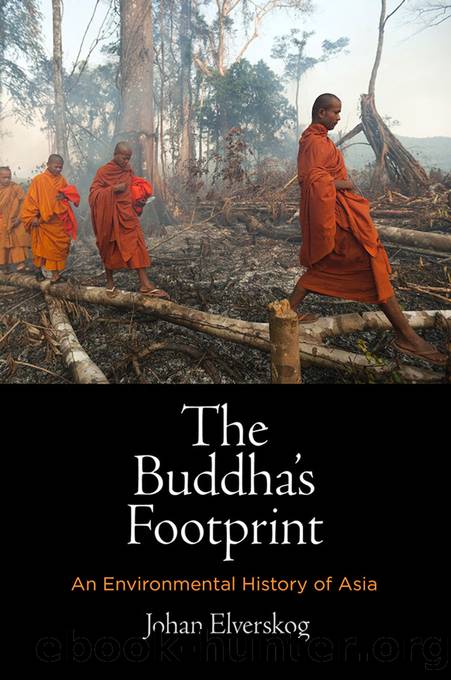The Buddha's Footprint: An Environmental History of Asia by Johan Elverskog

Author:Johan Elverskog [Elverskog, Johan]
Language: eng
Format: epub
ISBN: 9780812251838
Google: B8TRDwAAQBAJ
Publisher: University of Pennsylvania Press
Published: 2020-07-14T23:00:00+00:00
Chapter 10
The Buddhist Landscape
Temples were strewn like stars, and pagodas like flying wild geese.
—Samgukyusa, Memorabilia of the Three Kingdoms, Book 3
Although the Dharma and Buddhists played a pivotal role in the urbanization of Asia, they were not the sole causal factor in such a complicated historical development. In every case, from Mathura in India to Jiankang in China and Kyoto in Japan, many other people contributed to these urban realities. Nevertheless, Buddhists and the Dharma were the sole driving force in one sphere of activity: the politics of landscape.
By “politics of landscape” I refer to the dynamic whereby Buddhists—be they kings, businessmen, goldsmiths, or monks—transformed the landscape with Buddhist monasteries, temples, and stupas, and these structures in turn transformed social realities. As James Duncan has observed, “landscape … is one of the central elements in a cultural system, for as an assemblage of objects, a text, it acts as a signifying system through which a social system is communicated, reproduced, experienced, and explored.”¹ Wherever the Dharma became established, this landscape dynamic unfolded.² In some cases, landscape transformation was a state enterprise and in others it was not. In Sri Lanka, for example, Duncan has shown how the Kandy Kingdom performed its “good deeds” by building an explicitly Buddhist landscape: “The environmental evidence of these good deeds was a distinctively Asokan landscape which embodied and exemplified [Buddhist] values. In order to become a Buddha, kings devoted themselves to building religious structures, such as monasteries, dagobas and vihara, which would enrich the religion, as well as to public works such as irrigation tanks which would benefit the people.”³ Such transformation exerted political and religious control but it also produced a specifically Buddhist culture through landscape.⁴
Download
This site does not store any files on its server. We only index and link to content provided by other sites. Please contact the content providers to delete copyright contents if any and email us, we'll remove relevant links or contents immediately.
| Africa | Americas |
| Arctic & Antarctica | Asia |
| Australia & Oceania | Europe |
| Middle East | Russia |
| United States | World |
| Ancient Civilizations | Military |
| Historical Study & Educational Resources |
The Sympathizer by Viet Thanh Nguyen(4305)
The Rape of Nanking by Iris Chang(4136)
World without end by Ken Follett(3428)
Ants Among Elephants by Sujatha Gidla(3417)
Blood and Sand by Alex Von Tunzelmann(3138)
Japanese Design by Patricia J. Graham(3109)
City of Djinns: a year in Delhi by William Dalrymple(2514)
The Queen of Nothing by Holly Black(2492)
Foreign Devils on the Silk Road: The Search for the Lost Treasures of Central Asia by Peter Hopkirk(2433)
India's Ancient Past by R.S. Sharma(2416)
Inglorious Empire by Shashi Tharoor(2394)
Tokyo by Rob Goss(2388)
In Order to Live: A North Korean Girl's Journey to Freedom by Yeonmi Park(2344)
India's biggest cover-up by Dhar Anuj(2318)
Tokyo Geek's Guide: Manga, Anime, Gaming, Cosplay, Toys, Idols & More - The Ultimate Guide to Japan's Otaku Culture by Simone Gianni(2314)
The Great Game: On Secret Service in High Asia by Peter Hopkirk(2305)
Goodbye Madame Butterfly(2202)
Batik by Rudolf Smend(2123)
Living Silence in Burma by Christina Fink(2037)
